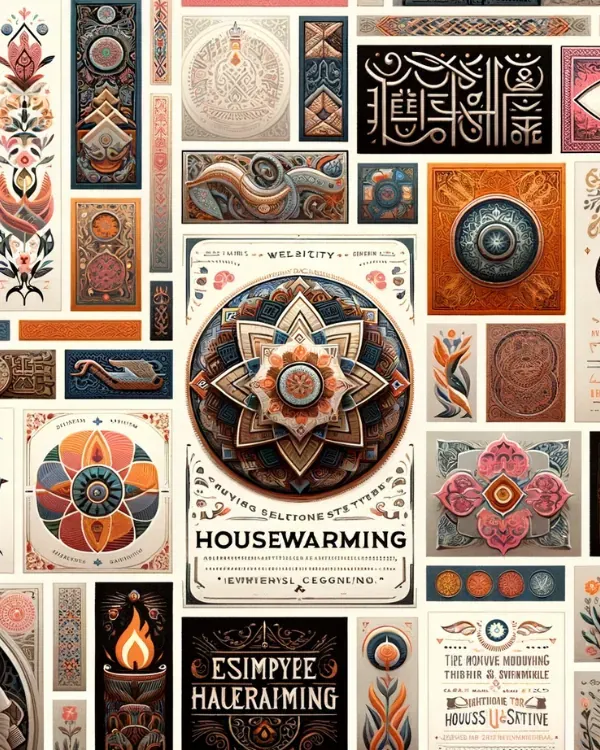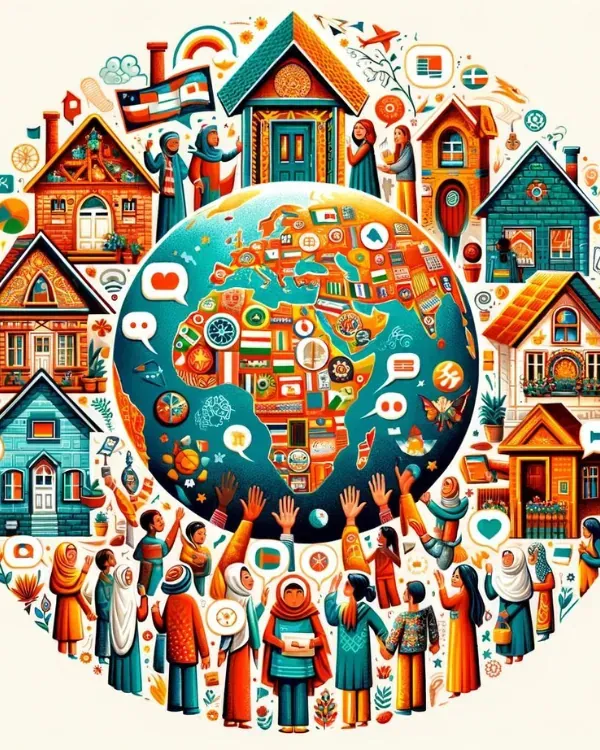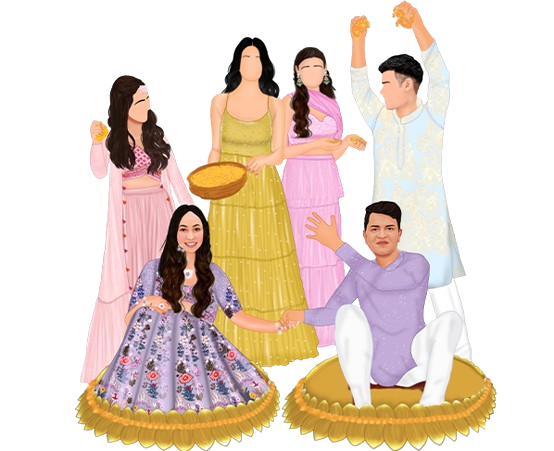Advertisement
By IS Team
The Influence of Cultural Traditions on Housewarming Invitations

Advertisement
The Influence of Cultural Traditions on Housewarming Invitations is vividly reflected in the diverse ways cultures around the world celebrate this significant life event. Asian cultures emphasize traditional symbols and colors, with Indian invitations featuring vibrant hues for joy, and Chinese relying on Feng Shui for harmony.
In contrast, Western cultures often lean towards personalized, modern designs, highlighting a shift towards individual expression. Middle Eastern and African invitations are deeply rooted in religious symbolism and community values.
The modern fusion of these diverse traditions, driven by globalization, has led to invitations that blend various cultural elements, creating a rich tapestry of global aesthetics. This evolution not only respects traditional values but also embraces the inclusivity and diversity of our contemporary world, illustrating how cultural traditions continue to shape and enrich the rituals of housewarming across the globe.
Cultural Traditions and Their Influence

Advertisement
A. Asian Cultures🏯:
Indian: In India, housewarming invitations are often imbued with vibrant colors and traditional symbols. The 'Swastika', a symbol of good luck and well-being, is commonly featured. These invitations are typically colorful, symbolizing joy, prosperity, and a warm welcome to the new home.
Chinese Feng Shui Principles in Invitations: Chinese housewarming invitations often incorporate Feng Shui principles, emphasizing balance and harmony. The choice of colors, symbols, and even the direction the invitation faces, can be influenced by Feng Shui to ensure good fortune for the new home.
Japanese 'New House' Ceremonies and Invitations: Japanese invitations for housewarming, known as 'Shin'yu-shiki', are characterized by their simplicity and elegance. This minimalist approach reflects traditional Japanese aesthetics, focusing on understated beauty and a serene presentation.
B. Western Cultures🌐:
European Historical Rituals Reflected in Invitations: European housewarming invitations often draw inspiration from local folklore, historical events, or symbols. These might include Celtic knots, medieval motifs, or imagery from local legends, adding a unique cultural touch to the invitations.
Modern American Trends in Housewarming Invitations: In the United States, there's a trend towards modern, minimalist designs in housewarming invitations. These often prioritize personalization, with homeowners opting for custom designs that reflect their personal style and the character of their new home.
C. Middle Eastern and African Cultures🕌🌍:
Symbolism and Language in Middle Eastern Invitations: Middle Eastern invitations typically feature intricate calligraphy, often including religious or poetic phrases. The use of rich, symbolic colors like gold, blue, and green is common, each color carrying its own cultural significance.
African Rituals and Their Reflection in Invitations: In African cultures, housewarming invitations may incorporate tribal motifs or symbols representing community, ancestry, and connection to the land. These invitations often reflect a deep respect for cultural heritage and communal ties.
Elements of Housewarming Invitations in Various Cultures

Advertisement
A. Design and Aesthetics:
| Culture | Color Schemes and Symbolism 🎨 | Traditional Motifs and Icons 🌟 |
|---|---|---|
| Indian | Bright colors like red, yellow (Joy, Prosperity) 🌈 | Swastika, Lotus (Good Luck, Purity) 🕉️ |
| Chinese | Red, Gold, Black (Balance, Wealth, Protection) 🔴⚫️🟡 | Yin Yang, Dragons (Harmony, Power) 🐉 |
| Japanese | Neutral, Earthy tones (Simplicity, Nature) 🌿 | Sakura, Carp (Beauty, Determination) 🌸🐟 |
| European | Local colors, Historical hues (Folklore, Tradition) 🎨 | Celtic knots, Crests (Heritage, Family) 🍃 |
| American | Varied, often pastel or earth tones (Modernity, Personalization) 🖌️ | Monograms, Modern Art (Individualism, Style) 🖼️ |
| Middle Eastern | Gold, Blue, Green (Spirituality, Wealth, Life) 💰💙💚 | Calligraphy, Geometric Patterns (Beauty, Precision) ✒️ |
| African | Vibrant, Earthy tones (Community, Nature) 🌍 | Tribal Patterns, Masks (Ancestry, Spirituality) 🎭 |
B. Wording and Language:
| Culture | Formal vs. Informal Tone | Examples of Proverbs or Cultural Quotes |
|---|---|---|
| Indian | Formal: Traditional and respectful | 'Atithi Devo Bhava' (The guest is equivalent to God) |
| Chinese | Formal: Often includes honorifics and respectful language | '家和万事兴' (Harmony in the family brings prosperity) |
| Japanese | Formal: Polite and humble | 'いらっしゃいませ' (Welcome, please come in) |
| European | Varies: Can be formal or informal depending on the region | Varies widely due to diverse languages and cultures |
| American | Informal: Personal and friendly | Commonly personalized messages |
| Middle Eastern | Formal: Polite and often includes religious greetings | 'Ahlan wa Sahlan' (Welcome) |
| African | Varies: Can be formal or informal, often communal in tone | Proverbs reflecting community and unity |
Role of Religion and Superstitions in Housewarming Invitations

Advertisement
Religious References in Invitations:
- Many cultures incorporate blessings or prayers specific to the homeowner's faith in their housewarming invitations.
- These references serve not only as a mark of respect to their beliefs but also as a way to seek divine blessings for the new home.
Superstitious Beliefs Impacting Invitation Choices:
- Across various cultures, elements intended to ward off evil spirits or bring good luck are often incorporated into housewarming invitations.
- This might include specific colors, symbols, or even the timing of sending out invitations.
Examples from Various Religions and Cultures:
- In Hindu culture, mantras like the Gayatri Mantra might be included for blessings.
- Islamic invitations may feature calligraphy of verses from the Quran.
- In Christian traditions, invitations might include biblical verses or crosses.
- East Asian invitations might have symbols like the Chinese Fu character (福), signifying good fortune.
- Jewish invitations could include phrases in Hebrew, invoking blessings.
These religious and superstitious elements in housewarming invitations are more than mere formalities; they are a profound expression of cultural identity and spiritual hopes for the new beginning. 🏠🙏✨
Modern Adaptations and Fusion of Traditions

Influence of Globalization on Traditional Invitations:
- Globalization has significantly impacted housewarming invitations, with traditional designs increasingly incorporating modern elements.
- This trend reflects a growing appreciation for various cultural aesthetics, leading to invitations that are both unique and globally appealing.
Blending of Cultural Elements in Contemporary Invitations:
- Modern invitations often showcase a fusion of diverse cultural elements, reflecting the multicultural nature of modern societies.
- For example, an invitation might combine traditional Indian patterns with a sleek, minimalist Western design, or use Japanese aesthetics alongside modern typography.
Case Examples of Fusion Housewarming Invitations:
- In global cities, it's common to find invitations that blend Western and Eastern elements, catering to diverse populations.
- A notable example could be an invitation using Chinese Feng Shui colors and layout, but with English and modern graphic design.
- Another instance might be an American-style invitation with Arabic calligraphy, reflecting the homeowner's cultural heritage and contemporary tastes.
These modern adaptations signify a cultural exchange that enriches the tradition of housewarming celebrations. They highlight how cultural boundaries are merging, creating a new, inclusive language of design and expression in housewarming invitations. 🎨💌
Etiquette and Protocols in Different Cultures

Advertisement
A. Guest Etiquette Based on Cultural Norms: Different cultures have varied expectations about guest behavior, from gift-giving to dress code.
B. Gift-Giving Traditions and Expectations: What is considered an appropriate gift can vary greatly.
C. RSVP and Attendance Customs: The importance of RSVPing and punctuality can differ across cultures.
Challenges and Considerations in Multicultural Settings

A. Balancing Diverse Cultural Expectations:
- Hosts often face the challenge of honoring their cultural traditions while also being inclusive of their guests' diverse backgrounds.
- This balance requires a thoughtful approach to invitation design, wording, and even the event planning itself to ensure all guests feel welcomed and respected.
B. Navigating Cultural Sensitivities and Misunderstandings:
- In a multicultural setting, it's crucial to be aware of potential cultural pitfalls. - What is considered a norm in one culture might be a faux pas in another.
- Awareness and sensitivity to these differences can prevent misunderstandings and ensure that all guests feel comfortable and valued.
C. Strategies for Inclusive and Respectful Invitations:
- Choosing neutral themes in the design and wording of invitations can be a way to avoid cultural bias or exclusion.
- Accommodating dietary restrictions is another important consideration, as food is a significant part of most housewarming celebrations.
- Understanding and respecting cultural nuances, such as dress codes, gifting traditions, or time punctuality, can greatly enhance the inclusivity of the event.
By addressing these challenges with sensitivity and thoughtfulness, hosts can create an environment that celebrates diversity and fosters a sense of community and belonging for all attendees. 🤝🏠
Frequently Asked Questions
Q1: How Can Technology Enhance Multicultural Housewarming Invitations?
Ans: Technology allows for interactive and accessible invitations, offering features like language translation and digital RSVP tracking to accommodate diverse guests.
Q2: Are Environmental Considerations Important in Choosing Housewarming Invitations?
Ans: Eco-friendly choices, such as digital invitations or recycled materials, reflect environmental consciousness and are increasingly popular in culturally diverse settings.
Q3: How to Handle Dietary Restrictions in a Multicultural Housewarming Party?
Ans: Offer a variety of food options, including vegetarian, vegan, and allergy-friendly choices, and clearly label dishes to accommodate all dietary needs.
Q4: What Role Do Social Media and Online Platforms Play in Modern Housewarming Celebrations?
Ans: Social media and online platforms facilitate invitation distribution, event detail sharing, and virtual participation, enhancing the community experience in housewarming events.
Advertisement
I'm Looking For!








